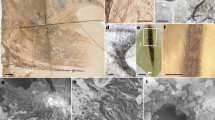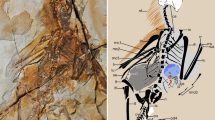Abstract
Pterosaurs were the first vertebrates to achieve true flapping flight, but in the absence of living representatives, many questions concerning their biology and lifestyle remain unresolved. Pycnofibres—the integumentary coverings of pterosaurs—are particularly enigmatic: although many reconstructions depict fur-like coverings composed of pycnofibres, their affinities and function are not fully understood. Here, we report the preservation in two anurognathid pterosaur specimens of morphologically diverse pycnofibres that show diagnostic features of feathers, including non-vaned grouped filaments and bilaterally branched filaments, hitherto considered unique to maniraptoran dinosaurs, and preserved melanosomes with diverse geometries. These findings could imply that feathers had deep evolutionary origins in ancestral archosaurs, or that these structures arose independently in pterosaurs. The presence of feather-like structures suggests that anurognathids, and potentially other pterosaurs, possessed a dense filamentous covering that probably functioned in thermoregulation, tactile sensing, signalling and aerodynamics.
This is a preview of subscription content, access via your institution
Access options
Access Nature and 54 other Nature Portfolio journals
Get Nature+, our best-value online-access subscription
$29.99 / 30 days
cancel any time
Subscribe to this journal
Receive 12 digital issues and online access to articles
$119.00 per year
only $9.92 per issue
Buy this article
- Purchase on Springer Link
- Instant access to full article PDF
Prices may be subject to local taxes which are calculated during checkout




Yuan Zhang
Similar content being viewed by others
Data availability
The data that support the findings of this study are available in the Supplementary Information.
References
Lucas, A. M. S. & Peter, R. Avian Anatomy: Integument (US Agricultural Research Service, Washington DC, 1972).
Barrett, P. M., Evans, D. C. & Campione, N. E. Evolution of dinosaur epidermal structures. Biol. Lett. 11, 20150229 (2015).
Xu, X. et al. An integrative approach to understanding bird origins. Science 346, 1253293 (2014).
Di-Poï, N. & Milinkovitch, M. C. The anatomical placode in reptile scale morphogenesis indicates shared ancestry among skin appendages in amniotes. Sci. Adv. 2, e1600708 (2016).
Chen, C. F. et al. Development, regeneration, and evolution of feathers. Annu. Rev. Anim. Biosci. 3, 169–195 (2015).
Mayr, G., Pittman, M., Saitta, E., Kaye, T. G. & Vinther, J. Structure and homology of Psittacosaurus tail bristles. Palaeontology 59, 793–802 (2016).
Zheng, X. T., You, H. L., Xu, X. & Dong, Z. M. An Early Cretaceous heterodontosaurid dinosaur with filamentous integumentary structures. Nature 458, 333–336 (2009).
Godefroit, P. et al. A Jurassic ornithischian dinosaur from Siberia with both feathers and scales. Science 345, 451–455 (2014).
Kellner, A. W. et al. The soft tissue of Jeholopterus (Pterosauria, Anurognathidae, Batrachognathinae) and the structure of the pterosaur wing membrane. Proc. R. Soc. B 277, 321–329 (2010).
Sharov, A. G. New flying reptiles from the Mesozoic of Kazakhstan and Kirgizia [in Russian]. Tr. Inst. Palaeontol. Akad. Nauk SSSR 130, 104–113 (1971).
Czerkas, S. A. & Ji, Q. in Feathered Dinosaurs and the Origin of Flight (ed. Czerkas, S. J.) 15–41 (The Dinosaur Museum, Blanding, 2002).
Unwin, D. M. & Bakhurina, N. N. Sordes pilosus and the nature of the pterosaur flight apparatus. Nature 371, 62–64 (1994).
Ji, Q. & Yuan, C. Discovery of two kinds of protofeathered pterosaurs in the Mesozoic Daohugou Biota in the Ningcheng region and its stratigraphic and biologic significances. Geol. Rev. 48, 221–224 (2002).
Xu, X., Zhou, Z., Sullivan, C., Wang, Y. & Ren, D. An updated review of the Middle–Late Jurassic Yanliao Biota: chronology, taphonomy, paleontology and paleoecology. Acta Geol. Sin. 90, 2229–2243 (2016).
Unwin, D. M. On the phylogeny and evolutionary history of pterosaurs. Geol. Soc. Lond. Spec. Publ. 217, 139–190 (2003).
Frey, E., Tischlinger, H., Buchy, M. C. & Martill, D. M. New specimens of Pterosauria (Reptilia) with soft parts with implications for pterosaurian anatomy and locomotion. Geol. Soc. Lond. Spec. Publ. 217, 233–266 (2003).
Lindgren, J. et al. Interpreting melanin-based coloration through deep time: a critical review. Proc. R. Soc. B 282, 20150614 (2015).
Lindgren, J. et al. Molecular composition and ultrastructure of Jurassic paravian feathers. Sci. Rep. 5, 13520 (2015).
Barden, H. E. et al. Morphological and geochemical evidence of eumelanin preservation in the feathers of the Early Cretaceous bird, Gansus yumenensis. PLoS ONE 6, e25494 (2011).
Bendit, E. Infrared absorption spectrum of keratin. I. Spectra of α-, β-, and supercontracted keratin. Biopolymers 4, 539–559 (1966).
Martinez-Hernandez, A. L., Velasco-Santos, C., De Icaza, M. & Castano, V. M. Microstructural characterisation of keratin fibres from chicken feathers. Int. J. Envir. Pollut. 23, 162–178 (2005).
Liu, Y. et al. Comparison of structural and chemical properties of black and red human hair melanosomes. Photochem. Photobiol. 81, 135–144 (2005).
Alibardi, L. Adaptation to the land: the skin of reptiles in comparison to that of amphibians and endotherm amniotes. J. Exp. Zool. 298B, 12–41 (2009).
Kreplak, L., Doucet, J., Dumas, P. & Briki, F. New aspects of the α-helix to β-sheet transition in stretched hard α-keratin fibers. Biophys. J. 87, 640–647 (2004).
Yassine, W. et al. Reversible transition between α-helix and β-sheet conformation of a transmembrane domain. Biochim. Biophys. Acta – Biomembr. 1788, 1722–1730 (2009).
Xu, X. et al. A bizarre Jurassic maniraptoran theropod with preserved evidence of membranous wings. Nature 521, 70–73 (2015).
Donoghue, P. C. J. & Benton, M. J. Rocks and clocks: calibrating the Tree of Life using fossils and molecules. Trends Ecol. Evol. 22, 424–431 (2007).
Baron, M. G., Norman, D. B. & Barrett, P. M. A new hypothesis of dinosaur relationships and early dinosaur evolution. Nature 543, 501–506 (2017).
Persons, W. S. IV & Currie, P. J. Bristles before down: a new perspective on the functional origin of feathers. Evolution 69, 857–862 (2015).
Ruxton, G. D., Persons, W. S. IV & Currie, P. J. A continued role for signaling functions in the early evolution of feathers. Evolution 71, 797–799 (2017).
Bullen, R. D. & McKenzie, N. L. The pelage of bats (Chiroptera) and the presence of aerodynamic riblets: the effect on aerodynamic cleanliness. Zoology 111, 279–286 (2008).
Caro, T. The adaptive significance of coloration in mammals. Bioscience 55, 125–136 (2005).
Homberger, D. G. & de Silva, K. N. Functional microanatomy of the feather-bearing integument: implications for the evolution of birds and avian flight. Am. Zool. 40, 553–574 (2000).
Scholander, P., Walters, V., Hock, R. & Irving, L. Body insulation of some arctic and tropical mammals and birds. Biol. Bull. 99, 225–236 (1950).
Ling, J. K. Pelage and molting in wild mammals with special reference to aquatic forms. Q. Rev. Biol. 45, 16–54 (1970).
Gao, J., Yu, W. & Pan, N. Structures and properties of the goose down as a material for thermal insulation. Text. Res. J. 77, 617–626 (2007).
Cunningham, S. J., Alley, M. R. & Castro, I. Facial bristle feather histology and morphology in New Zealand birds: implications for function. J. Morphol. 272, 118–128 (2011).
McNamara, M. E., Briggs, D. E. G., Orr, P. J., Field, D. J. & Wang, Z. Experimental maturation of feathers: implications for reconstructions of fossil feather colour. Biol. Lett. 9, 20130184 (2013).
Colleary, C. et al. Chemical, experimental, and morphological evidence for diagenetically altered melanin in exceptionally preserved fossils. Proc. Natl Acad. Sci. USA 112, 12592–12597 (2015).
Wang, X. et al. Basal paravian functional anatomy illuminated by high-detail body outline. Nat. Commun. 8, 14576 (2017).
Kaye, T. G. et al. Laser-stimulated fluorescence in paleontology. PLoS ONE 10, e0125923 (2015).
Xu, X., Zheng, X. & You, H. Exceptional dinosaur fossils show ontogenetic development of early feathers. Nature 464, 1338–1341 (2010).
Pagel, M. Detecting correlated evolution on phylogenies: a general method for the comparative analysis of discrete characters. Proc. R. Soc. Lond. B 255, 37–45 (1994).
Paradis, E. Analysis of Phylogenetics and Evolution with R (Springer Science & Business Media, New York, 2011).
Bapst, D. W. paleotree: an R package for paleontological and phylogenetic analyses of evolution. Methods Ecol. Evol. 3, 803–807 (2012).
Bell, M. A. & Lloyd, G. T. strap: an R package for plotting phylogenies against stratigraphy and assessing their stratigraphic congruence. Palaeontol. 58, 379–389 (2015).
Revell, L. J. phytools: an R package for phylogenetic comparative biology (and other things). Methods Ecol. Evol. 3, 217–223 (2012).
Acknowledgements
We thank Q. Ji, S. Ji and H. Huang for access to the specimen CAGS–Z070, as well as S. C. Kohn, Y. Fang, C. Wang and T. He for laboratory assistance. This work was supported by the National Natural Science Foundation of China (41672010 and 41688103) and Strategic Priority Research Program (B) of the Chinese Academy of Sciences (XDB26000000) to B.J., Research Grant Council of Hong Kong-General Research Fund (17103315) to M.P., ERC-StG-2014-637691-ANICOLEVO to M.E.M. and Natural Environment Research Council Standard Grant NE/1027630/1 to M.J.B.
Author information
Authors and Affiliations
Contributions
B.J. and M.J.B. designed the research. Z.Y., B.J. and X.X. systematically studied the specimens. Z.Y., S.L.K., M.E.M. and P.J.O. performed the SEM analysis. Z.Y. and B.J. performed the FTIR analysis. M.P. and T.G.K. performed the laser-stimulated fluorescence imaging, data reduction and interpretation. M.J.B. performed the maximum-likelihood analyses. Z.Y., B.J., M.J.B., M.E.M., X.X. and P.J.O. wrote the paper. All authors approved the final draft of the paper.
Corresponding authors
Ethics declarations
Competing interests
The authors declare no competing interests.
Additional information
Publisher’s note: Springer Nature remains neutral with regard to jurisdictional claims in published maps and institutional affiliations.
Supplementary information
Supplementary Information
Supplementary Results, Figures, Tables and References
Rights and permissions
About this article
Cite this article
Yang, Z., Jiang, B., McNamara, M.E. et al. Pterosaur integumentary structures with complex feather-like branching. Nat Ecol Evol 3, 24–30 (2019). https://doi.org/10.1038/s41559-018-0728-7
Received:
Accepted:
Published:
Issue Date:
DOI: https://doi.org/10.1038/s41559-018-0728-7
This article is cited by
-
Predatory synapsid ecomorphology signals growing dynamism of late Palaeozoic terrestrial ecosystems
Communications Biology (2024)
-
New insights into pterosaur cranial anatomy: X-ray imaging reveals palatal structure and evolutionary trends
Communications Biology (2024)
-
Preservation of corneous β-proteins in Mesozoic feathers
Nature Ecology & Evolution (2023)
-
The selfish preen: absence of allopreening in Palaeognathae and its socio-cognitive implications
Animal Cognition (2023)
-
A colourful view of the origin of dinosaur feathers
Nature (2022)



